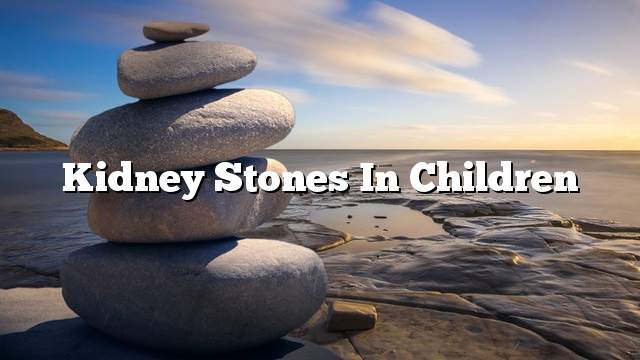kidney stones
Stones in the kidneys (urinary tract) is one of the most prevalent diseases recently among children, as it was previously a disease that affects men more than women in the advanced stages of age, has become widespread among all age groups regardless to sex, and affects about one in every 650 children in different countries of the world. The main reason for it is practising bad habits in, in which children eat in their lives, and here we will talk more about kidney stones, types and treatment.
There are several types of kidney stones, but children are exposed to one or two types mostly, depending on the nature of children’s bodies.
- Type I: calcium oxalate stones, the most common type of urinary stone in the world.
- Type II: ammonium phosphate and the rate of infection is small compared to other.
The rest of the species are associated with adults more than children, with the possibility of infection of adults with the above mentioned, such as:
- Boric acid.
- Cysteine stones.
Causes of stones in children
- Change in healthy habits and unhealthy eating habits to eat foods that contain large amounts of spices daily.
- The lack of fluid in the body, which leads to non-breakage of those substances and remove them from the body, where they settle in the kidneys or ureters.
- Drink a lot of soft drinks and add non-natural sugar juices.
- Dryness of the body of fluid, reduces the number of urination when the child leads to the accumulation of stones within the kidneys over time.
- Weight gain, lack of exercise and daily motor activities.
- The child is exposed to prematurity for a long period of his life.
- Take medications that help build up the salts in the urine.
- Genetic causes.
- Increased hypercalcemia in urine.
- Environmental changes on the child.
- Congenital defects and malformations of the urinary system.
- Repeated urinary tract infections.
- The incidence of certain diseases that reduce the lack of secretion of calcium, and increase in the bowels of the intestine, such as fibrous sac disease.
Kidney stones symptoms in children
- The feeling of severe pain in the abdominal area, which is one of the most clear signs and indications that show the presence of gravel in children.
- The pain in the waist towards the kidneys.
- Feeling pain during urination.
- Blood drop from the ureter during urination in advanced cases.
- Nausea and vomiting sometimes, knowing that the degree of pain and symptoms vary from child to child, and to adults as well.
“Important Information”:
- Some cases of kidney stones do not carry any of the previous symptoms, and appear on the child suddenly, and the presentation of his strength and intensity at once without warning, in which case the child must be immediately treated to avoid damage to the kidney, or bladder, and in some cases gravel out during urination, and pain occurs at the stage of urination, and then the pain is removed and the child feels comfortable.
Methods of treatment of kidney stones in children
- Consult patients with gallstones and kidneys. Many radiographic and laboratory images are taken to obtain clear and adequate evidence of gravel. Procedures are taken as appropriate. Cases are usually simple. Large amounts of fluid are taken daily and continuously, and avoiding factors that lead to stones; not eating food and drink that are harmful to health, which have been mentioned previously.
- Prescriptions that work on the fragmentation of gravel, and decides under medical supervision depending on the condition of the patient and what the situation calls for.
- Surgical operations, or removal through Nador, in the presence of large size stones that can not be treated.
